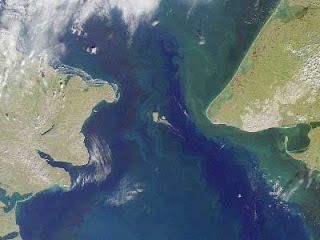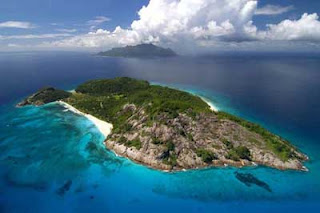Ocean or sea is a vast sea and the salty water mass that covers the surface of the dial-connect the Earth bounded by continents or large islands. Oceans cover 71% of the earth's surface, with an area of about 361 million square kilometers, the contents ofthe ocean about 1370 million km ³, with an average depth of 3790 meters. Smaller parts of the ocean is the sea, strait, bay. Below is a list of the world's five oceans, from the largest to smallest:
1. Ocean Pacific (179.7 million km ²)
Pacific Ocean is the world's largest body of water. He covers approximately one third of the Earth's surface, with an area of 179.7 million km ² (69.4 million mi ²). The length ofapproximately 15,500 miles of Bering Sea ice in the Arctic to the restrictions in the Ross Sea in Antarctica in the south. Pacific Ocean reaches its greatest east-west width at about 5 degrees N latitude, where it stretches approximately 19,800 km fromIndonesia to the coast of Colombia. Western ocean boundary is usually placed in the Strait of Malacca. The lowest point of the Earth's surface-are-the Mariana Trench in the Pacific Ocean. Ocean is located between Asia and Australia to the west, America in the east, the Antarctic in the south and the Arctic Ocean to the north. Ocean Pacific contains about 25,000 islands (more than the number of islands in the oceans of the world if combined), the majority located in the south of the equator.
2. Atlantic Ocean (106.4 million km ²)
Atlantic Ocean is the world's second largest ocean, covering about 1 / 5 the surface of the Earth. The word comes from Greek mythology Atlantic, which means "Sea of Atlas". This Ocean S-shaped, extending from the northern hemisphere to the southern hemisphere, is divided in two by the equator into the North Atlantic and South Atlantic.Bordered by North America and South America in the western part of the ocean andEurope and Africa in the eastern ocean. Covers approximately 20% of Earth's surface,the Atlantic Ocean is second largest in terms of size after the Pacific Ocean. Togetherwith the ocean surrounding it have an area of 106,450,000 km ², if the seas around itare not counted, the extent of 82,362,000 km ². The number of areas that flow into theAtlantic Ocean four times larger than the Pacific Ocean and Indian Ocean. Volume of the Atlantic Ocean with the surrounding seas is 354,700,000 km ³ and without it is323,600,000 km ³.
Average depth of the Atlantic Ocean, with the surrounding ocean is 3332 m (10,932 ft);without it is 3926 m (12,877 feet). The greatest depth, 8,605 m (28,232 ft), located in the Puerto Rico Trench. The width of the Atlantic varies from 2,848 km (1,769 miles)between Brazil and Liberia to about 4830 km (3,000 miles) between the United States and northern Africa.
3. Indian Ocean (73.440 million km ²)
Hinda Ocean or Indonesia ocean is the third largest body of water in the world,covering approximately 20% of Earth's water surface. In the north bounded by the south Asia; on the west by the Arabian Peninsula and Africa; in the east by the Malay Peninsula, Sumatra, Java, Lesser Sunda Islands, and Australia; in the south by Antarctica. Ocean are separated by the Atlantic Ocean by 20 ° east meridian, and withthe Pacific Ocean by 147 ° East meridian. Indian Ocean or the Indian Ocean is the onlyocean that use the name of the country that is India.
4. Antarctic Ocean (20.327 million km ²)
Antarctic Ocean or Southern Ocean is the mass of sea water surrounding the Antarctic continent. He is the fourth largest ocean and has agreed to be called the ocean by the International Hydrographic Organization (IHO) in 2000. Before that, the general view is the Atlantic Ocean, Indian Ocean and Pacific Ocean beach directly adjacent to theAntarctic.
Sea water temperature varies between 10 and -2 ° C. Cyclone runs from the east around the continent and frequently are powerful storms due to real differences intemperature between the ice shelf with the open sea. Latitude ocean regions of 40 LS to the Antarctic Circle is a region with an average wind speed of more vigorous than any place on earth. In winter, the ocean freezes until it reaches 65 ° latitude in the Pacificsector and up to 55 ° latitude in the Atlantic sector, the surface temperature drops below 0 ° C. At some point on the coast of the continent, is still found ice-free areas,this is due to the strong winds that constantly blow from the continent towards the ocean.
Antarctic ice blanket minimum swell of 2.6 million km ² in March reached 18.8 million km ² in September, meaning the extent of increased nearly seven-fold. Antartic circum polar current (over 21,000 miles) moved eastward; is the world's largest oceancurrent, drain 130 million m³ of water per second, means 100 times the entire flow of river water in the world.
5. Arctic Ocean (14.056 million km ²)
The Arctic Ocean is located in the northern hemisphere and mostly in the Arctic North Pole, is the smallest and most shallow ocean between the five oceans of the world.Although the International Hydrographic Organization (IHO) regard it as an ocean,ocean experts call it the Arctic Mediterranean Sea or the Arctic Sea, classifying it asone of the Mediterranean Sea belonging to the Atlantic Ocean.
Many parts of the Arctic ocean covered by ice, either in winter or year-round.Temperature and salinity in the Arctic ocean varies depending on the season depending on the ice cover is melting or melted; salt levels are the lowest of the average of five other oceans, due to low evaporation, also due to the limited release of water from the ocean into the surrounding area with water input freshwater into the ocean in large numbers. The number of ice-melting ice in the summer reach 50%.
Uniknya.com
Uniknya.com










No comments:
Post a Comment